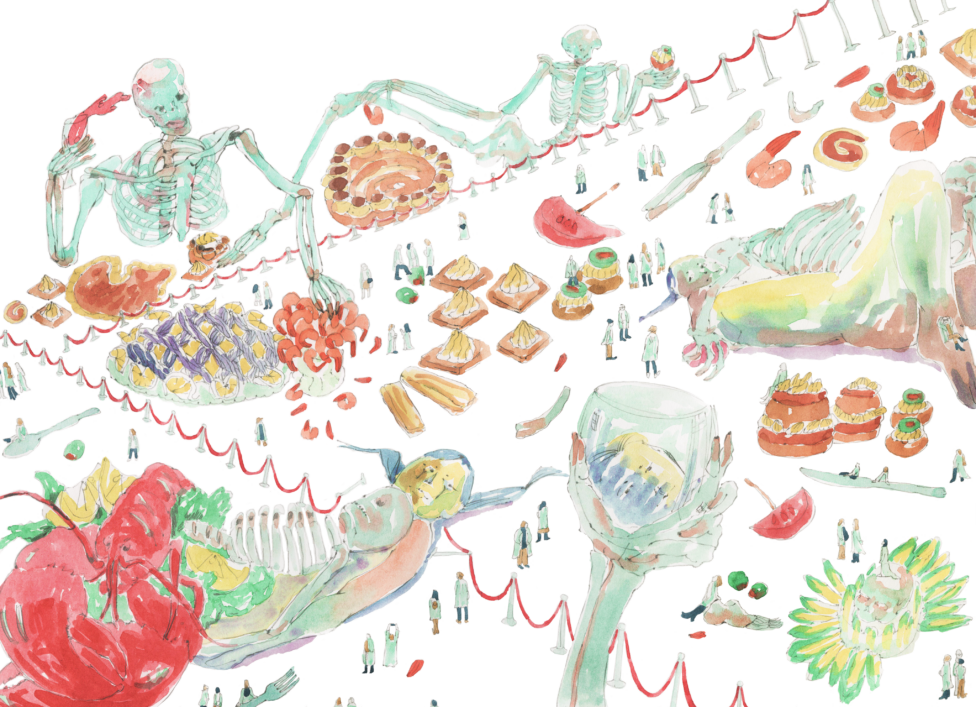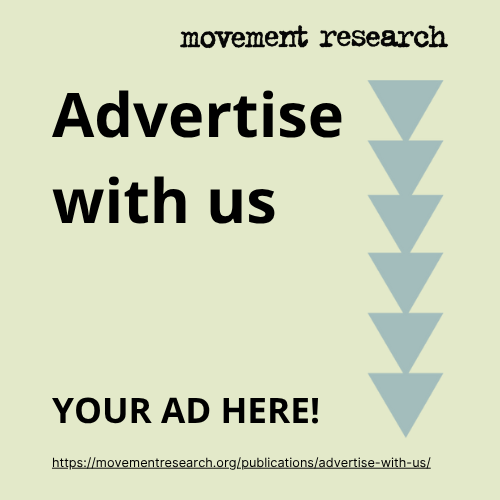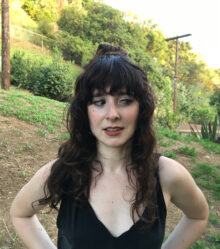Critical Correspondence has long been invested in the problem/opportunity of dance in the museum and today is no different. On the occasion of publishing an anthology of personal accounts by performers called Being Work, Dorothy Dubrule sits down with Martita Abril to discuss what it’s like to be the work in a visual arts museum. Why do visual artists get uplifted for projects that have choreographers have already explored? How is the art handled when the art is human? How do we talk about art as object when the art happens within an interaction?
—Londs, CC Co-editor
This conversation was edited for the purpose of publication.

Photo courtesy of the artist.
Martita Abril
Should we do this like a podcast? Hello, DD. Welcome to Critical Correspondence at Movement Research.
Dorothy Dubrule
Thank you so much. I’m so happy to be here.
MA
I’m looking forward to the book of essays that you edited, Being Work. How did you come to this fantastic idea?
DD
It came from having done a lot of this kind of work, which is to say, being a delegated performer in visual arts spaces.
Because of the funding that exists and the arts infrastructure in Los Angeles, where I’m based, the majority of paid work for folks in the experimental performance community and of the western dance tradition, is coming from museums and galleries much more commonly than it comes from choreographers.
We have almost no brick and mortar dedicated dance spaces here. So the majority of the work that I was doing, and that I saw my peers in the performance community doing, was in visual arts spaces. Conversations were always happening in green rooms, or the gallery office space that we used as a green room (laughs). And I found the conversations very fascinating. I love gossip. I think that gossip is a huge community builder, really.
MA
Oh yeah. I always think about becoming the archives. But it’s just our names, not our experiences getting archived. I’m glad that you are highlighting us.
DD
What I’m not sure has been addressed as much is how the work gets encountered by people who come into museums, and that exchange between performer and audience is the primary experience of the work. All the ways that you experience performance work being valued in an interpersonal exchange—that happens in gallery spaces so differently.
MA
So differently. It’s so right in your face.

Photo courtesy of the artist.
DD
It’s proximity, but also, there aren’t social norms of silence and distanced seating where you can’t see the audience and the lights are off. And we applaud when it’s over. Occasionally, you hear applause in a gallery space. And when you do, it feels very funny and sweet. But a lot of times, you don’t. A lot of times, people just walk away.
MA
Or they won’t look at you! They just sit there on their phones! Privacy is just out the door. They’re taking videos and photos and not necessarily being present. They’re taking the photo as a way of saying, “I was here.” But really, they’re not there. Often, they don’t even look directly at you.
DD
I mean, it’s uncomfortable. It’s uncomfortable to walk into a space and see someone performing when you weren’t expecting it. If you’re not someone who goes to see performance or really likes it. Then yeah, you don’t want to look at them.
MA
And you don’t know what they’re gonna do!
DD
It’s scary. Absolutely.
MA
Yeah, there’s this sense of—Oh, my God, something’s gonna happen. And depending on what you already know, like, some people are naked?
I don’t have experience performing naked in a museum or gallery setting. Have you experienced that?
DD
Quite a lot.
MA
How was that for you?
DD
In the Tino Sehgal work that I write about, I’m stripping, down to no bra and just my underwear by the end. So it evoked a lot of crossovers between sex work and performance work, and also the exploitation, aesthicization, and misappropriation of the real conditions of sex workers for art purposes. The Hammer is a free museum, so I would get regulars coming to the gallery. There was something incredibly unnerving about seeing the same people over and over again… and the unspoken conversations that I would have with these folks in our through our eyes, where I’m trying to communicate: “get the fuck out of here. This is inappropriate. You’ve seen this already.”
MA
By the end of the day, you’re just exhausted. And we can’t get fixed by art handlers or conservators like paintings and objects. We actually have to go to PT or other therapists in order to continue doing this kind of work.
DD
Maintenance work, although I do think there’s some degree of art handling, like being handled by museum staff. Not necessarily physically. But you know, the escort in and out. There’s something that felt very much like being art handled.
MA
Yeah, totally.
DD
The choreography of properly installing and de-installing the work.
In addition to all of these things, the sheer difference of the artwork material! Being a person versus an object, and the issues that creates in terms of compensation, green room conditions, temperature, hardness, and all of these issues.

Photo courtesy of the artist
MA
I mean, those performances lasted for a long time. That’s also another layer: how long was that exhibition running for? Simone Forti’s Dance Constructions was three days or four days a week, three times a day. So you’re there from 11am to 5pm. You go, you rest, and then you go, then you rest, then you go. For almost a year.
DD
It’s like being a Broadway dancer.
There’s a rigor in it, and there’s something very exciting about it too, but it does reach a boring, totally mundane place as well. There’s an arc.
MA
But sometimes, even under those conditions, performers want to know what the mind might go through… what the body might go through… They want to see if they’re able to…
DD
That’s something that the book grapples with. There are many reasons why performers take this work. There is a really exciting challenge in it! I think there is something alluring about that for performers, in spite of the conditions, and doing durational work, working in stillness—there is a lot to explore there. It really strengthens your practice as a performer to engage in this field.
MA
How did you choose these performers to have these essays as part of this book?
DD
This book could have been much bigger. There are so many stories that were not told.
But, there are a number of challenges in asking folks to contribute this kind of writing. People don’t necessarily want to share details if they feel like it’ll prevent them from getting more work in the future. There’s the connotation of being a whistleblower, even if what you’re saying is not particularly damning. And, it’s not uncommon to sign NDAs for doing this kind of work. So there was that. But also, I wasn’t able to compensate folks for their writing. It was entirely volunteer. And a lot of performers doing this work are very gig-to-gig. Plus, a lot of folks don’t have a writing practice and were not comfortable working in this way.
In the introduction, I describe the limits on the perspectives that we get, because there are a lot of demographics that aren’t represented in the book and a lot of modes of performing that aren’t represented. But the hope is that this is really seen as a small slice of a huge breadth of diverse experiences. I hope it serves as an entry point.
MA
And you also wrote an essay?
DD
Yes. My essay in the book—it’s the last essay and it’s about performing in Tino Sehgal’s work Selling Out. I had already been working on this book when I wrote that essay, but it was published separately on Open Space through SFMOMA a few years ago. And so I did go through the reception of that—Tino Sehgal’s reception of it, the Hammer curators’ reception of it.
The degree of blowback was interesting, considering what I felt were pretty mild things to say about the experience. Plus, my goal was to really de-center the artists, Tino, the curators, the institution, and instead focus on the work of performing it. That’s really where my interest lies.
But Tino told me that because of this essay, [he] wasn’t going to perform that work anymore. And, yeah, I think it ruffled some feathers. But I continue to have a good relationship with those curators and one of them even presented on that essay. That’s really the goal: open lines of communication between all of the members of this ecosystem. It’s not just the performers, it’s the artists making this work, it’s the curators who are bringing performance into these spaces, it’s the institutions, and it’s the folks who come out to the gallery. It’s not as simple as just looking at the artists or the curators.

Photo courtesy of the artist.
MA
I was curious about if you had a favorite essay in the collection. One that maybe stood out to you or you felt that you related?
DD
I have an intimate relationship with each of the essays, because I edited each piece and went back and forth with the artist. With a couple of them, it was actually like a series of conversations that were transcribed and then edited and edited and edited to become the writing so it’s certainly impossible for me to pick out just one.
But there are details from each one that stick with me and I think about all the time. Like in Casey Brown’s essay about performing in Maria Hassabi’s PLASTIC. I always laugh when she describes museum visitors just being really bored by the work and you know, sometimes they would just open the door to the gallery she was in and say “ugh”—
MA
—and close it?
DD
It’s relatable from both ends! I’ve walked into a gallery and been like: “No, I’m not interested in this.” You know, there’s a certain freedom in that.
I love Jessica Emmanuel writing about Xu Zhen’s work, In Just a Blink of an Eye. Just the sort of straightforwardness of: I’m gig-to-gig. I do this work and I forget it as soon as it’s over.
MA
It pays my bills for that time and then…
DD
Exactly. I’m willing to give as much as is given to me.
In situations where the artist is never there, in pieces where it’s very much about being a living sculpture, you’re still the entire time and it’s like a guessing game for gallery attendees. Is it real or not?
I’ve done a fair amount of that performance work. There’s some play in the beginning, and then it gets old. Then you’re just in a really psychedelic land of meditation and stillness. I love that Jessica gets into that in her essay. Mireya Lucio’s essay on performing Marina Abramović’s work at the MOCA gala really makes me laugh and makes me very emotional in some ways, too. It’s kind of a heartbreaking experience of feeling so isolated and vulnerable when you’re on a tabletop in front of people that are making fun of you and not able to connect with you. It all feels very relatable. I also love the second to last essay, Paul Hamilton writing about the Bruce Nauman retrospective, and…
MA
I was there for that.
DD
Yeah. Grappling with the respect with which Bruce Nauman is treated.That essay really gets at the dynamic between the visual arts and dance in terms of what kind of cachet or glamor it carries and the importance with which it is treated. Paul is writing about these incredible choreographers that he works with that museum-going audiences have likely never heard of. And then Bruce Nauman does this embodied action one time and all these amazingly talented performers years later are re-enacting it. Whereas the majority of choreographers, dance artists, they’ll never reach that height.
What’s being drawn upon and referenced by visual artists making comparable work? The dancers and choreographers who inspired it—they’ll never be credited. Or receive the kind of recognition and value that’s placed on Nauman’s work. I think in the end, Paul says something like: “Yeah, I think I’m over Bruce Nauman now.”







